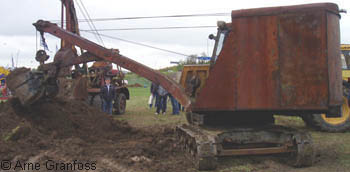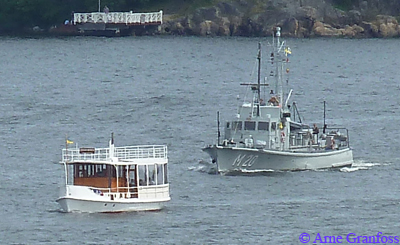Refugees from Denmark

 UNDER CONSTRUCTION Version 0.41
UNDER CONSTRUCTION Version 0.41
|
Sweden in World War II - across borders
|
 |
![]()
In some areas it is not so far between Denmark and Sweden.

But it is a long way for someone on the run.
![]()
On 9 April 1940 a Danish officer led parts of the 11th batallion from Roskilde to Helsingør and the short ferry trip to Helsingborg in Sweden.
He assumed that Sweden too was at war with Germany [s10]. In Helsingborg they were met by some Swedish customs officers and passport officials.
The Swedish armed forces were prepared, up in the north of Sweden. [s13]
The Danish soldiers were told to march to a military base north of the city. Later they were moved and disarmed, but the Danish officer got the key to the weapon storage. The soldiers went back to Denmark after some weeks. [s13]
![]()
Among the Danes who fled via Sweden to Britain was the former Danish minister of trade, whose anti-German comments had led to the termination of his position and freedom to speech.
He had been called by the British government, and became the chairman of the Danish Counsil in London - and a voice from BBC for illegal Danish radio listeners. [s13]
![]()
![]()
In 1943 the resistance in Denmark grew, with more sabotage. On 29 August the German military declared a state of emergency in Denmark. Among others the Danish
military was disarmed. [s13]
The Danish supreme commander of the Danish Navy had the previous night given the officers of the Navy units the order, that on a given signal either sink their ships or sail to Sweden. [s19]
Several ships were sunk by their Danish crews. [s13]
One cruiser was bombed on the way to Sweden. Seven torpedo boats and minesweepers made it to Sweden, and the crews were officially detained. [s19]
Around 400 Danish military men came to Sweden at the time, and treated as civilians since Denmark wasn't considered to be a warfaring nation. [s60]
![]()
On 28 September 1943 an official at the German Foreign Office in Copenhagen first warned a couple of Danish friends, then informed the Swedish ambassador in
Copenhagen, and then went to Stockholm to inform the Swedish prime minister. The German SS had planned a raid to arrest judes in the night 1 - 2 October. [s13]
On 29 September 1943 the Swedish foreign office warned Germany about the negative effect this action would have on the public opinion in Sweden, and told that Sweden was willing to intern the Danish Jews. There was no respons from Germany. [s27]
The Germans had planned to arrest around 8,000 Danish Jews in October 1943, but only some 500 were sent to a concentration camp. Well over 7,000 were helped by other Danes to hide, and in October and November transported to Sweden. [s58]
The same day as the German action against Danish Jews began, on 1 October 1943, Sweden offered Germany to receive all Danish Jews. No response. Among the other Swedish activities: Danish Jews with connections to Sweden became Swedish citizens, and permissions to enter Sweden were given to Danish Jews and stateless Jews who lived in Denmark without limitations. [s60]
 With various kinds of boats, with Danish and Swedish crews, many got to Sweden where the authorities were prepared to take care of them. [s13]
With various kinds of boats, with Danish and Swedish crews, many got to Sweden where the authorities were prepared to take care of them. [s13]
The Swedish minesweeper M 20 was in service in various areas on Sweden's west coast during WWII. In September-October 1943 she took onboard at least 84 refugees from Danish boats, and on 22 December another 23 from a Danish fishing boat. [s66]
Almost all Jews in Denmark managed to escape to Sweden in October 1943. [s28]
On 9 October Washington was informed that almost all Danish Jews had been transported to Sweden. This gave new energy to the Intergovernmental Committee on Refugees, and they contacted London and Washington about the never issued Allied guarantee to repatriate refugees in neutral countries after the war - with this Sweden was prepared to receive another 20000 Jewish refugees. The Allies continued their discussions. [s27]
 Some days in October close to 1,500 people per day fled from Denmark to Sweden. At the beginning of 1944 there were 12,000 Danish refugees in Sweden (7,500 Jews), and when the year came to its end they were 15,000. [s60]
Some days in October close to 1,500 people per day fled from Denmark to Sweden. At the beginning of 1944 there were 12,000 Danish refugees in Sweden (7,500 Jews), and when the year came to its end they were 15,000. [s60]
![]()
Danish scouts who had fled to Sweden got special education in Gränna. [s13]
![]()
In 1944 the problems for the Germans to keep control over the Danish citizens continued, where Danes among others performed strikes, sabotage and murder of selected Danes who cooperated with the Germans.
The Germans had organized their own sabotage group. During the late summer the Germans irritation over the passive Danish police resulted in a false air raid alarm to get the policemen to assemble at the police stations.
1680 policemen were arrested and sent to Germany. Of the 6000 who were not caught, several fled to Sweden. [s19]
A German Bücker Bü 181 C-1 was shot down by Swedish anti-aircraft on 6 July 1944. Out from the wreck crept a Danish refugee. He had stolen the empty plane when the engines were warmed up, and started before the German technicians understood what was going on. (Some parts of the wreck was returned to Denmark, a deal that included that a couple of USA airmen interned in Sweden could travel back to their unit in Britain.) [s77]
Two icebreakers and Denmarks largest ferry were sailed to Sweden in late 1944. [s19]
![]()
Some 11 000 Danes fled to Sweden, among them many Danish jews. [s06]
During World War II some 17 000 Danes had fled to Sweden, of them 7000 jews with families. [s19]
![]()
The Danish brigade (the Danish policemen who had been trained in Sweden) sailed from Sweden to Denmark on 6 May 1945. Then followed other Danes who had spent war time in Sweden, among others those who had been rescued from Germany by "the white buses" expedition in March and April 1945. [s58]
2019-04-07. www.granfoss.se. Text/pictures: Arne Granfoss